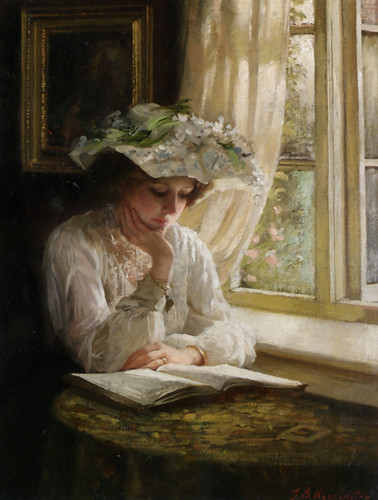When painting images at night, Korovin explored the tonal contrasts of the dark night sky and bright street-lighting. At times he painted flames flickering in lanterns, with dashes of paint evoking a synchronous dance of light and shadow along the street. At other times he painted the softer, atmospheric qualities of the late evening hours, thereby creating a scene of dark blues and greens where the eye must strain to discern the landscape beyond the foreground. In the present Vichy scene, the artist masterfully combines these techniques, creating an image that is at once peaceful and dynamic, inviting and alive. This painting was sold by Sotheby's on November 5, 2008 for $302,500.
[Oil on canvas, 69 x 97 cm]

![Henri Rousseau - View of the Fortifications to the left of the Gate of Vanes [1909] by Gandalf's Gallery](http://farm7.staticflickr.com/6052/6429984919_c7506613b5.jpg)


![Edward Cucuel - An Outing By Boat [1917] by Gandalf's Gallery](http://farm8.staticflickr.com/7150/6417507305_a2d9cebd37.jpg)
![William Fettes Douglas - Self-Portrait [c.1845] by Gandalf's Gallery](http://farm7.staticflickr.com/6049/6417507461_e622444efa.jpg)
![Studio of Francois Boucher - The Billet-Doux [1754] by Gandalf's Gallery](http://farm8.staticflickr.com/7029/6410314611_de824844f3.jpg)
![Edouard Gaertner - The Friedrichsgracht, Berlin [1830s] by Gandalf's Gallery](http://farm8.staticflickr.com/7026/6410324819_4fb8be9d57.jpg)
![James Jebusa Shannon - Jungle Tales (Contes de la Jungle) [1895] by Gandalf's Gallery](http://farm8.staticflickr.com/7026/6404354503_d852688d16.jpg)

![Helene Schjerfbeck - Dancing Shoes [1882] by Gandalf's Gallery](http://farm8.staticflickr.com/7168/6398858241_e033ac2516.jpg)
![Helene Schjerfbeck - Smiling Girl [1921] by Gandalf's Gallery](http://farm8.staticflickr.com/7163/6398855487_8a7cd74f74.jpg)
![Frederick McCubbin - At Colombo [1907] by Gandalf's Gallery](http://farm8.staticflickr.com/7159/6393744681_55cf992374.jpg)
![Augustus John - Lyric Fantasy [c.1913-14] by Gandalf's Gallery](http://farm8.staticflickr.com/7173/6393745429_702b023a6f.jpg)
![Luigi Premazzi - Southern Market Place [1861] by Gandalf's Gallery](http://farm8.staticflickr.com/7035/6388125353_c25f7a0131.jpg)
![Richard Karlovich Zommer - Sohbet [1910] by Gandalf's Gallery](http://farm7.staticflickr.com/6043/6388125679_e180187ecc.jpg)
![Mihaly Munkacsy - The Story of a Battle [c.1875] by Gandalf's Gallery](http://farm7.staticflickr.com/6212/6382055099_5e938f4b86.jpg)
![Eugène Delacroix - Henri IV Conferring the Regency upon Marie de' Medici [before 1834] by Gandalf's Gallery](http://farm7.staticflickr.com/6033/6382052621_340671c778.jpg)
![Follower of Hieronymus Janssens - Ladies and Gentlemen Playing La Main Chaude [c.1655-65] by Gandalf's Gallery](http://farm7.staticflickr.com/6215/6375423955_898b30cf9d.jpg)

![Theodore Rousseau - A Swamp in the Landes [after 1844] by Gandalf's Gallery](http://farm7.staticflickr.com/6095/6368271357_bbd2e0fac1.jpg)
![Jan van de Cappelle - A Small Vessel in Light Airs, and Another Ashore [c1650-60] by Gandalf's Gallery](http://farm7.staticflickr.com/6037/6368268863_5794980a5d.jpg)
![Francesco Guardi - Venice: The Grand Canal with Palazzo Pesaro [c.1775-60] by Gandalf's Gallery](http://farm7.staticflickr.com/6119/6362191293_a7e65b9673.jpg)
![Jean-Léon Gérôme - The End of the Sitting [1886] by Gandalf's Gallery](http://farm7.staticflickr.com/6214/6362191519_ca7263ab4d.jpg)
![Frederic Edwin Church - Aurora Borealis [1865] by Gandalf's Gallery](http://farm7.static.flickr.com/6236/6357374585_57a51a25cc.jpg)


![Master of Flémalle - Portrait of a Fat Man [c.1425] by Gandalf's Gallery](http://farm7.static.flickr.com/6108/6352221425_232d56e924.jpg)


![William Merritt Chase - Study of Flesh Colour and Gold [1888] by Gandalf's Gallery](http://farm7.static.flickr.com/6019/6346385623_51d7f7232f.jpg)
![Joseph Mallord William Turner - Rain, Steam, and Speed - The Great Western Railway [1844] by Gandalf's Gallery](http://farm7.static.flickr.com/6047/6346385459_1084514de4.jpg)

![Jan Mandijn - Burlesque Feast [c.1550] by Gandalf's Gallery](http://farm7.static.flickr.com/6038/6343059577_6ffd8d94d7.jpg)
![William Merritt Chase - Ring Toss [1896] by Gandalf's Gallery](http://farm7.static.flickr.com/6102/6339341417_44640c553e.jpg)
![Promenade, Winter in New York [1895] by Gandalf's Gallery](http://farm7.static.flickr.com/6213/6339341873_8921095931.jpg)
![Charles-Melhior Descourtis - The Lover Caught Unawares [c.1790] by Gandalf's Gallery](http://farm7.static.flickr.com/6219/6336221477_54e91150aa.jpg)
![John George Brown - The Music Lesson [1870] by Gandalf's Gallery](http://farm7.static.flickr.com/6112/6336977822_ccc71d4b62.jpg)
![Claude-Joseph Vernet - A Sporting Contest on the Tiber in Rome [1750] by Gandalf's Gallery](http://farm7.static.flickr.com/6239/6334249696_88de47bdb0.jpg)
![William Sergeant Kendall - Psyche [1909] by Gandalf's Gallery](http://farm7.static.flickr.com/6230/6334249760_925e85348e.jpg)
![Charles Courtney Curran - Betty Newell [1922] by Gandalf's Gallery](http://farm7.static.flickr.com/6240/6330856833_c3270269d4.jpg)
![John Everett Millais - The North-West Passage [1874] by Gandalf's Gallery](http://farm7.static.flickr.com/6104/6330854411_ff494e84aa.jpg)
![Albert Marie Lebourg - View of Pont-du-Chateau [1885-86] by Gandalf's Gallery](http://farm7.static.flickr.com/6120/6328671026_7298328da7.jpg)
![Willem Koekkoek - View of Oudewater [c.1867] by Gandalf's Gallery](http://farm7.static.flickr.com/6234/6327917949_0e6c535a9b.jpg)
![Henry Alexander - In the Laboratory [c.1885-87] by Gandalf's Gallery](http://farm7.static.flickr.com/6238/6325459176_602dbdf6e5.jpg)
![Mary Cassatt - The Boating Party [1893-94] by Gandalf's Gallery](http://farm7.static.flickr.com/6092/6325458836_89b16a3d2d.jpg)
![Odilon Redon - Flower Clouds [c.1903] by Gandalf's Gallery](http://farm7.static.flickr.com/6236/6321829312_9bf418666d.jpg)

![Rembrandt - Adam and Eve [1638] by Gandalf's Gallery](http://farm7.static.flickr.com/6052/6317916874_49414c21eb.jpg)
![Hans Thoma - Adam and Eve [1897] by Gandalf's Gallery](http://farm7.static.flickr.com/6100/6317395043_64febbb6a3.jpg)